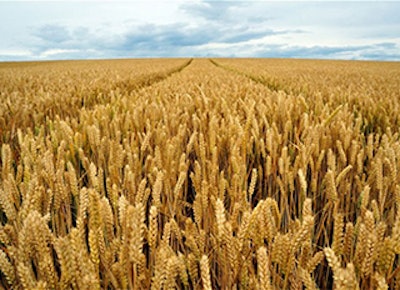
(AP) — Kansas is expected to produce its smallest winter wheat crop since 1996, an indication of a deepening drought across the nation's wheat belt, the government said in its first official forecast of the growing season. The National Agricultural Statistics Service estimated the state will produce 260.4 million bushels of winter wheat this year, based on May 1 crop conditions. The production estimate is down 18 percent from last year. But even that forecast might be overly optimistic, given that it does not reflect the impact of triple-digit temperatures that baked parts of the state earlier this week.
"There has been nothing that will improve the condition of the crop from the track it has been on," said Lucas Haag, Extension Agronomist at Kansas State University's research center in Colby. The agricultural service forecast Kansas anticipates average yields of 31 bushels-per-acre, down seven bushels-per-acre from last year, and also the lowest average yield since 1996 in Kansas.
The 1996 comparison might be particularly apt, as it was also a year of extreme drought in the state. Precipitation in 1996 was scarce during the important October to April wheat growing period. That year Kansas also saw extreme temperature swings, including freezing temperatures in late April similar to weather patterns this year, records show. This latest crop production report also estimates that Kansas growers will harvest an estimated at 8.4 million wheat acres, unchanged from last year.
It anticipates that Kansas will harvest 90 percent of its planted acres. During last year's drought just 88 percent of the planted acres were harvested and the rest were abandoned. Some industry experts are expecting this year's prediction of harvested acreage to be revised downward in coming months. "Given what has happened in the country in dry condition since field survey was done, you could build a case the harvested acres numbers probably, very likely, will decline," said Dan O'Brien, Extension market analyst at Kansas State University.
The agency's initial production estimate is in line with last week's prediction of 260 million bushels calculated by the Wheat Quality Council's Hard Winter Wheat Tour. Scouts who fanned out across the state during the tour also estimated yields at 33.2 bushels per acre, a bit more upbeat than the newly released official yield projection for Kansas.
Nationwide, total wheat production is forecast at 1.4 billion bushels, down nine percent from a year ago. The agricultural service's average projected wheat yield for the nation is 43.1 bushels per acre, down slightly more than four bushels from a year ago. Anticipated U.S. production of the various wheat types include:
- Hard red winter wheat, the type commonly grown in Kansas, is forecast to be up slightly nationwide with the government estimating U.S. production at 746 million bushels.
- Growers are expected to harvest 447 million bushels of soft red winter wheat nationwide, down 21 percent from a year ago.
- White wheat production nationwide is estimated at 209 million bushels, down seven percent from last year. Of the white wheat, 10.9 million bushels are expected to be hard white wheat and 198 million bushels are soft white.
Kansas continued to lead the nation in winter wheat production even with its more modest projection as drought has also taken a toll in states across the southern wheat belt. Washington was forecast to have the next highest production with 112.7 million bushels, followed by Montana with 103.4 million bushels of winter wheat.























